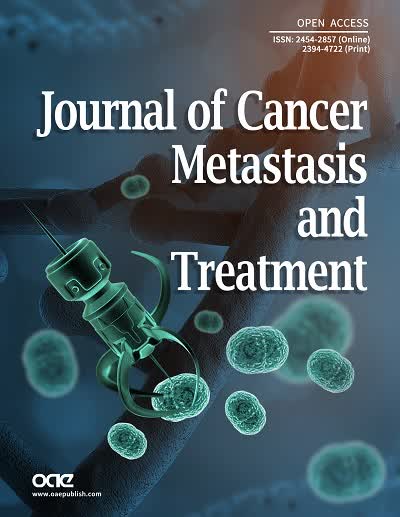REFERENCES
1. World Health Organization. Cancer today. In: International Agency for Research on Cancer; 2022. Available from: https://gco.iarc.fr/today/home [Last accessed on 29 March 2022].
2. Bai R, Lv Z, Xu D, Cui J. Predictive biomarkers for cancer immunotherapy with immune checkpoint inhibitors. Biomark Res 2020;8:34.
3. Robert C, Long GV, Brady B, et al. Nivolumab in previously untreated melanoma without BRAF mutation. N Engl J Med 2015;372:320-30.
4. Daud AI, Wolchok JD, Robert C, et al. Programmed death-ligand 1 expression and response to the anti-programmed death 1 antibody pembrolizumab in melanoma. J Clin Oncol 2016;34:4102-9.
5. Moschetta M, Uccello M, Kasenda B, et al. Dynamics of neutrophils-to-lymphocyte ratio predict outcomes of PD-1/PD-L1 blockade. Biomed Res Int 2017;2017:1506824.
6. Berghmans E, Jacobs J, Deben C, et al. Mass spectrometry imaging reveals neutrophil defensins as additional biomarkers for anti-PD-(L)1 immunotherapy response in NSCLC patients. Cancers 2020;12:863.
7. Berghmans E, Baggerman G. Mass spectrometry (imaging) for detection and identification of cyclic AMPs: focus on human neutrophil peptides (HNPs). In: Enany S, Masso-silva J, Savitskaya A, editors. Insights on Antimicrobial Peptides. IntechOpen; 2021.
9. Zeng X, Yang P, Chen B, et al. Quantitative secretome analysis reveals the interactions between epithelia and tumor cells by in vitro modulating colon cancer microenvironment. J Proteomics 2013;89:51-70.
10. Chen CY, Chi LM, Chi HC, et al. Stable isotope labeling with amino acids in cell culture (SILAC)-based quantitative proteomics study of a thyroid hormone-regulated secretome in human hepatoma cells. Mol Cell Proteomics 2012;11:M111.011270.
11. Zougman A, Selby PJ, Banks RE. Suspension trapping (STrap) sample preparation method for bottom-up proteomics analysis. Proteomics 2014;14:1006-0.
12. Meier F, Brunner AD, Koch S, et al. Online parallel accumulation-serial fragmentation (PASEF) with a novel trapped ion mobility mass spectrometer. Mol Cell Proteomics 2018;17:2534-45.
13. Cockx M, Blanter M, Gouwy M, et al. The antimicrobial activity of peripheral blood neutrophils is altered in patients with primary ciliary dyskinesia. Int J Mol Sci 2021;22:6172.
14. Ghose A, Gullapalli SVN, Chohan N, et al. Applications of proteomics in ovarian cancer: dawn of a new era. Proteomes 2022;10:16.
15. Choy E, Rose-john S. Interleukin-6 as a multifunctional regulator: inflammation, immune response, and fibrosis. J Scleroderma Relat Disord 2017;2:S1-5.
16. Neurath MF, Finotto S. IL-6 signaling in autoimmunity, chronic inflammation and inflammation-associated cancer. Cytokine Growth Factor Rev 2011;22:83-9.
17. Roe K, Gibot S, Verma S. Triggering receptor expressed on myeloid cells-1 (TREM-1): a new player in antiviral immunity? Front Microbiol 2014;5:627.
18. Tammaro A, Derive M, Gibot S, Leemans JC, Florquin S, Dessing MC. TREM-1 and its potential ligands in non-infectious diseases: from biology to clinical perspectives. Pharmacol Ther 2017;177:81-95.
19. Bouchon A, Dietrich J, Colonna M. Cutting edge: inflammatory responses can be triggered by TREM-1, a novel receptor expressed on neutrophils and monocytes. J Immunol 2000;164:4991-5.
20. Adams DH, Lloyd AR. Chemokines: leucocyte recruitment and activation cytokines. Lancet 1997;349:490-5.
22. Stepanova VV, Tkachuk VA. Urokinase as a multidomain protein and polyfunctional cell regulator. Biochemistry 2002;67:109-18.
23. Cesarman-Maus G, Hajjar KA. Molecular mechanisms of fibrinolysis. Br J Haematol 2005;129:307-21.
24. Kobayashi SD, DeLeo FR. Role of neutrophils in innate immunity: a systems biology-level approach. Syst Biol Med 2009;1:309-33.
25. Carmo AA, Costa BR, Vago JP, et al. Plasmin induces in vivo monocyte recruitment through protease-activated receptor-1-, MEK/ERK-, and CCR2-mediated signaling. J Immunol 2014;193:3654-63.
27. Xu Y, Harder KW, Huntington ND, Hibbs ML, Tarlinton DM. Lyn tyrosine kinase: accentuating the positive and the negative. Immunity 2005;22:9-18.
28. Krebs DL, Chehal MK, Sio A, et al. Lyn-dependent signaling regulates the innate immune response by controlling dendritic cell activation of NK cells. J Immunol 2012;188:5094-105.
29. Paul S, Lal G. The molecular mechanism of natural killer cells function and its importance in cancer immunotherapy. Front Immunol 2017;8:1124.
30. Blanco P, Palucka AK, Pascual V, Banchereau J. Dendritic cells and cytokines in human inflammatory and autoimmune diseases. Cytokine Growth Factor Rev 2008;19:41-52.
31. Fu YL, Harrison RE. Microbial phagocytic receptors and their potential involvement in cytokine induction in macrophages. Front Immunol 2021;12:662063.
32. Amaral MM, Davio C, Ceballos A, et al. Histamine improves antigen uptake and cross-presentation by dendritic cells. J Immunol 2007;179:3425-33.
33. Magna M, Pisetsky DS. The role of HMGB1 in the pathogenesis of inflammatory and autoimmune diseases. Mol Med 2014;20:138-46.







